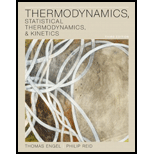
Interpretation: The value of q, w,
Concept Introduction: The change in internal energy is calculated as follows:
Here, n is number of moles,
The work done is represented as follows:
Here, P is external pressure and
The enthalpy of a reaction is represented as follows:
Here, n is number of moles, R is Universal gas constant and
Want to see the full answer?
Check out a sample textbook solution
Chapter 2 Solutions
Thermodynamics, Statistical Thermodynamics, & Kinetics
- Benzoic acid, C6H5COOH, is a common standard used in bomb calorimeters, which maintain a constant volume. If 1.20 g of benzoic acid gives off 31, 723 J of energy when burned in the presence of excess oxygen and in a water bath having a temperature of 24.6 C, calculate q, w, H, and U for the reaction.arrow_forwardThe Dieterici equation of state for one mole of gas is p=RTe-aVRTV-b Where a and b are constants determined experimentally. For NH3g, a = 10.91 atm. L2 and b = 0.0401 L. Plot the pressure of the gas as the volume of 1.00 mol of NH3g expands from 22.4 L to 50.0 L at 273 K, and numerically determine the work done by the gas by measuring the area under the curve.arrow_forwardWhat is the finaltemperature of0.122 mole ofmonatomic ideal gas that performs 75J of work adiabatically if the initial temperature is 235C?arrow_forward
- Many compressed gases come in large,heavy metal cylindersthat are so heavy that they need a special cart to move them around. An80.0-Ltank ofnitrogen gas pressurized to 172 atm is left in the sun and heats from its normal temperature of 20.0C to 140.0C. Determine a the final pressureinsidethe tank and b the work, heat, and U of the process. Assume that behavior is ideal and the heatcapacity of diatomic nitrogenis 21.0J/mol.K.arrow_forwardWhat are the two ways that a final chemical state of a system can be more probable than its initial state?arrow_forwardgas undergoes an adiabatic expansion from 10 − 3 m 3 to 8 × 10 − 3 m 3 . The adiabatic line for the gas is given by P 3 V 5 = C (C is a constant). (a) Calculate the reversible work performed along the adiabatic line if the initial pressure is 10 5 P a and the initial volume = 10 − 3 m 3 . (b) What is the value of the constant C ? What is the unit of C ? (c) The gas reaches the final state in a two step process. An expansion at a constant initial pressure to the final volume followed by a decrease in pressure to the final volume 8 × 10 − 3 m 3 . What is the reversible work and heat in this process?arrow_forward
- Calculate the change in molar enthalpy DHm when the given gas is heated from 25 oC to 500 oC using the expression above. The constants a, b, and c are available in Table 2B.1.arrow_forwardfor the reaction Cr(C6H6)2 (s) → Cr(s) + 2 C6H6 (g) ArU© (583 K) = + 8.0 kJmol-1. find the corresponding reaction enthalpy and estimate the standard enthalpy of formation of Cr(C6H6)2(is) at 583K. The constant-pressure molar heat capacity of benzene is 81.67 JK-1 mol- 1 as a gas. The heat capacities of graphite and hydrogen are approximately constant in this temperature range.arrow_forwardSuppose 2.00 mol of a monatomic ideal gas (cy = }R) is expanded adiabatically and reversibly from a temperature T = 300 K, where the volume of the system is 20.0 L, to a volume of 60.0 L. Calculate the final temperature of the gas, the work done on the gas, and the energy and enthalpy changes.arrow_forward
- a) Suppose that attractions are the dominant interaction between gas molecules, and the equation of state is p = nRT/V – n2a/V2. Determine the work (W(non-ideal gas)) of reversible, isothermal expansion of such a gas from initial volume V (initial) = 20.0 L to final volume V(final) = 40.0 L if n = 2.00 mol, T = 300 K, and a = 3.621 atm-L2/mol2. Watch your units. (b) Determine the work (W(ideal gas) of reversible, isothermal expansion of an ideal gas from initial volume V (initial) = 20.0 L to final volume V(final) = 40.0 L if n = 2.00 mol and T = 300 K. (c) Show the difference W(non-ideal) – W(ideal). If all your calculations are done correctly, this result shows you the effect of attractive interaction between gas particles on the work done by the system.arrow_forwardThe molar heat capacity of oxygen at constant pressure can be expressed as follows: Cp,m = a + bT, where a = 6.15 cal mol-1 K-1and b = 0.0031 cal mol-1 K-2. a) 2 mols of oxygen have been heated up reversibly from 27 ºC to 127 ºC, at a constant pressure of 1 atm. Calculate the w, q, ΔU and ΔH of the process. b) Same thing, assuming an isocoric process. The oxygen behaves as an ideal gas.arrow_forward6E. A 2.25 mole sample of CO,(g), for which C,.m=37.1 J/K at 298 K, expands reversibly and adiabatically from a volume of 4.50 L and a temperature of 298 K to a final volume of 32.5 L. Calculate the final temperature, q, w, AH and AU for the process. Assume that the gas behaves ideally and that C. is p.m constant over this temperature interval.arrow_forward
 Physical ChemistryChemistryISBN:9781133958437Author:Ball, David W. (david Warren), BAER, TomasPublisher:Wadsworth Cengage Learning,
Physical ChemistryChemistryISBN:9781133958437Author:Ball, David W. (david Warren), BAER, TomasPublisher:Wadsworth Cengage Learning, Principles of Modern ChemistryChemistryISBN:9781305079113Author:David W. Oxtoby, H. Pat Gillis, Laurie J. ButlerPublisher:Cengage Learning
Principles of Modern ChemistryChemistryISBN:9781305079113Author:David W. Oxtoby, H. Pat Gillis, Laurie J. ButlerPublisher:Cengage Learning Chemistry: The Molecular ScienceChemistryISBN:9781285199047Author:John W. Moore, Conrad L. StanitskiPublisher:Cengage Learning
Chemistry: The Molecular ScienceChemistryISBN:9781285199047Author:John W. Moore, Conrad L. StanitskiPublisher:Cengage Learning


